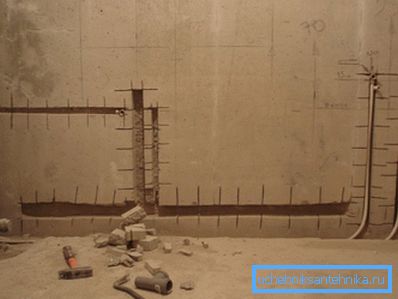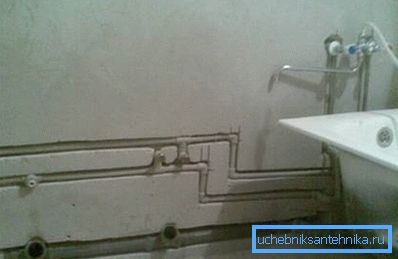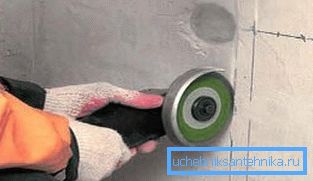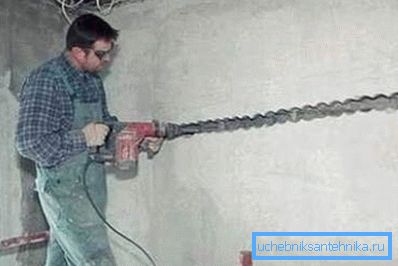How is the construction of walls for indoor pipes
It is hardly possible today to find admirers of the Soviet system of laying pipes in the apartment network of water supply and gasification. This steel web of a strangely intertwined plumbing in the most prominent place in the kitchen causes almost a nervous shiver to many. The question is, are there really no alternative methods of laying the pipeline, so to speak, more practical ones? Will chipping walls under pipes help?

The device furrows for laying communications
Now, when laying pipes in the interior space, in order to increase the aesthetics of the premises, it is customary to hide communications in the following ways:
- Behind fake walls, ceilings.
- In boxed decorative designs. (See also the article Pipe box: features.)
Sometimes pipelines are simply immured in walls, floors, and ceilings in special grooves, made in the right places. These grooves are also called chimneys for pipes (electric, television, radio cables), and the process of their construction, respectively, by chipping.
With all the seeming simplicity, it has its own specific rules, it requires a serious approach and knowledge:
- In what places you can make furrows.
- How to make a wall under a pipe in hard-to-reach places.
- What is to be laid in the groove.
- What tools can be used for these purposes.

Process features
So, a small instruction on the device strobe in the finished structures:
- In grooves, you can hide any communication that does not require periodic maintenance.
- Objects hidden in the tomb must not exceed 1/3 the thickness of the wall in size (thickness).
- In monolithic buildings, recesses in the walls for pipes and other networks can be made only to a depth not exceeding the depth of the reinforcement cage.
Attention! Building codes and regulations prohibit arranging chimneys for pipes in load-bearing walls and slabs of panel structures, thereby lowering the bearing capacity of structures. This can lead to unpredictable and inevitable consequences.
Starting the device of the furrows for the construction of life-support networks for the home by yourself, take into account the main rules for the conduct of this process:
- In order not to fall when performing work on the old electrical wiring, it is better to de-energize it and bury it forever in the structures.
- Hidden distribution of water pipes in a collision with cutting and gouging tools can cause a lot of problems. In this case, the repair will have to be done by the neighbors, therefore, in the absence of technological schemes for all communications, the best way to turn off the water supply.
- The process of shaving creates quite a lot of dust, and small fragments of concrete, brick, etc. are also possible. It is necessary to observe safety precautions and use personal protective equipment for eyes and respiratory organs.
- The size of the furrows should be optimal. Too deep or wide grooves will entail a significant overrun of materials in the process of their termination after the laying of communications.

The device of the grooves under the pipelines of water supply, heating and electrical cables differ in the technology of the work and the depth of laying in the groove. In this article we will talk about how to build a wall under the pipes.
Furrows under water and heating pipelines
Note! Due to the fact that bulk pipes, unlike electrical wiring, require more space, the main task of shaving is to preserve the strength and bearing capacity of structures.
The main tools for making pipe grooves are:
- Bulgarian (angular grinding machine).

- Perforator.
Tip! Mindful of how difficult it is to work blindly, make an executive plan for laying the pipeline in advance and save it until future repairs.
Shaving technology
Now we will describe a phased course of work:
- It is necessary to begin work with drawing the scheme of laying in nature (on the wall). This can be done with chalk or with a pencil.
- Then with the help of the grinder cut through the deep grooves along the edges of the marked grooves. The space between the edges of the same grinder break into small areas with transverse cuts. This will facilitate the removal of material from the grooves.
- You can start gouging wall material (concrete, brick, cinder block, etc.) between the edge cuts using a perforator.
Of course, the best option for such a tool is a wall chaser, created specifically for this purpose.
It provides everything for the device of the furrows of excellent quality:
- Installing two diamond discs at once.
- The ability to adjust the distance between the disks.
- Connecting an industrial vacuum cleaner to the dust collector device.
The only "but" is its high price. Therefore, builders use universal tools to reduce the cost of shtenbing the walls under the pipes. Those who do not have the opportunity to purchase equipment, you can rent a tool, the main thing is to carefully work, so as not to damage the equipment.

Conclusion
Strobenie walls under pipes can not be called laborious, however, if you still have never faced repair or construction work, you should practice to get a little experience. In the presented video in this article you will find additional information on this topic.
